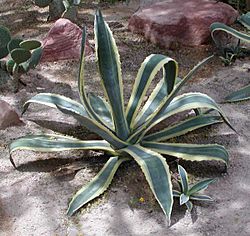Agavaceae facts for kids
Quick facts for kids Agave family |
|
|---|---|
 |
|
| Agave americana | |
| Scientific classification | |
| Kingdom: | |
| Division: | |
| Class: | |
| Order: | |
| Family: |
Agavaceae
Hutchinson
|
| Type genus | |
| Agave |
|
The Agave family, or Agavaceae, is a group of plants. Many plants in this family grow in hot, dry places. Some even live in the desert! Well-known plants from this family include the agave, yucca, and the tall Joshua tree. There are about 550 to 600 different kinds of plants in this family. They are found all over the world in tropical, subtropical, and warm areas.
Contents
What is the Agave Family?
Scientists group plants into "families" based on how they are related. The Agave family is a large group of plants. It includes about 18 different main groups, called genera (plural of genus). Each genus then has many different species (kinds of plants).
Scientists are always learning new things about plants. Sometimes, they change how they group plants together. For example, some plants like Cordyline and Dracaena used to be in their own family. Now, many scientists think they belong in a bigger family called Ruscaceae.
New studies using DNA have helped scientists learn more. These studies suggest that the Agave family might be even bigger! It could include plants like Chlorogalum and Camassia. This would add up to 22 more genera to the family.
What Do Agave Plants Look Like?
Many plants in the Agave family are succulents. This means they have thick, fleshy parts that store water. This helps them survive in dry places.
Most Agave plants have leaves that grow in a circle, like a rosette. These leaves grow from a short, woody stem. Some plants, like the Joshua tree, can even grow into tall trees!
The leaves of Agave plants usually have parallel veins. They are often long and pointed. Many have a hard, sharp spine at the end. Some even have more spines along their edges.
How Are Agave Plants Used?
Agave plants are very useful!
- Some Agave species are used to make drinks like pulque and mezcal.
- Other types are valued for their strong fibres. These fibers can be used to make ropes, mats, and clothes.
- Many Agave plants are popular for xeriscaping. This is a way of gardening that uses plants that need very little water. Agave plants are great for this because they are so good at storing water.
- Many Agave plants also have beautiful, showy flowers.
See also
 In Spanish: Agavóideas para niños
In Spanish: Agavóideas para niños

